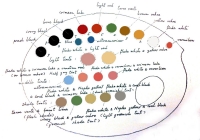Are modern substitutes for ancient or expensive pigments the same color as the original ones? Many artists pose this question and the opinions vary from person to person. While many pigments have been produced for centuries, others have had a distinct and limited lifespan. Colors once celebrated for revolutionizing the art world are now just entries in books and historical records.
Many pigments have had dubious histories. Being an artist and handling dangerous and in some cases lethal compounds, should have given an artist pause to consider alternatives. However, knowledge of the depth of the inherent danger of pigments, to some degree, was misunderstood. In the 15th through 17th century, industrial progress had limited impact on the art materials trade. However, the industrial revolution would introduce a wide variety of new materials with pigments derived from advancements in chemistry and modern methods of industrial production.
A number of artists lament the passing of the pigments that were standards in the ancient world. Due to the dangers inherent in some pigments, the high cost of manufacturing or toxic byproducts that are produced when making certain pigments, many well known colorants have been discontinued. So, do the modern, safer substitutes come close to match the color of their ancient counterparts?
Visual comparisons by the human eye and a suitable, uniform light source is one method to assess how good an old, now discontinued pigment relates to a new substitute. Another way is to take a measurement using a device called a spectrophotometer that assesses the color reflectance at wavelength segments within the range of visible light detectable by a human eye. A spectrophotometer provides the reflectance of a color that is be expressed in mathematical terms and can be analyzed and plotted as a graph. This removes the subjectivity in judgement or lack of color sensitivity that humans can inject into making color assessments. In addition, color is related to the light source in which it is viewed. Vary the color temperature of the light and a pigment can look different. A spectrophotometer maintains a constant, calibrated light that eliminates that bias. Let's examine how three historic pigments match spectrally with modern equivalents.



